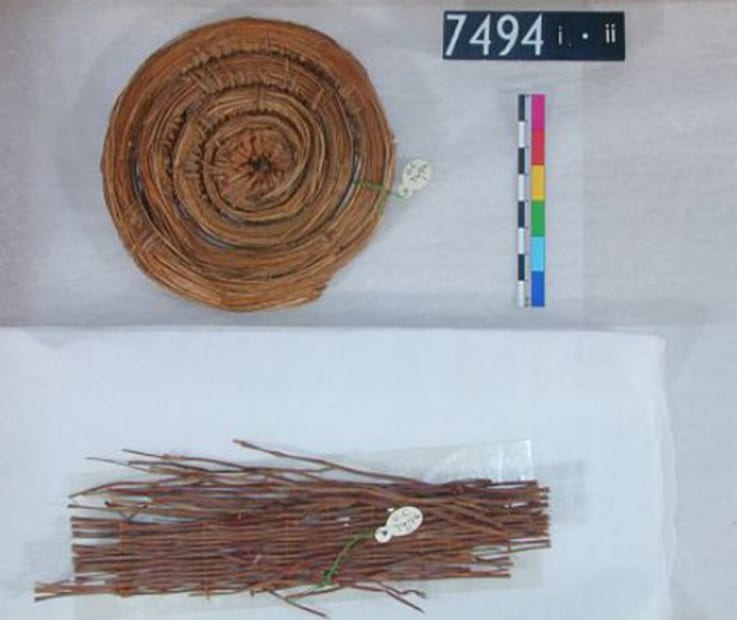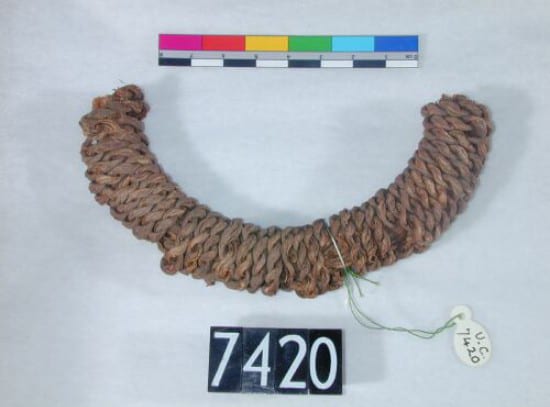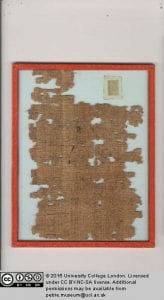The End of Art is Peace
By Mark V Kearney, on 2 August 2018
The title of this blog refers to a favourite line from Seamus Heaney’s The Harvest Bow, a poem that explores the humanity of the writer’s father as he crafts a decorative knot made of woven straw reeds, a traditional Irish custom strongly linked with courtship and marriage (you can see my own example below).
https://www.instagram.com/p/KdU-w3wmYY/?utm_source=ig_web_copy_link
Since beginning the role of Student Engager earlier this year, I have found myself thinking of this poem more frequently; one reason for this is that the Petrie Museum holds in its collection an example of a woven basket, in front of which I always stand during my shifts. The similarities of form between two objects separated by both thousands of years and miles has made me wonder just how universally pervasive the skill was.
Let me just mention one other important fact about all this… I’ve a background in physics and my current PhD research is based on the decay of modern materials like plastics in museums. Basket making — especially the ancient form — is a little out of my comfort zone!
It therefore came as a shock to me that the weaving skills I learnt in the classroom (as every Irish child does) can be traced back to before the use of pottery. As Carolyn McDowall mentions, many “weaving techniques reflect the geographical location of the many and varied culturally different groups”. The beauty of traditional skills such as these is they can offer a connection, via our hands, to the past as little has changed in the way we construct them over thousands of years.
From a personal viewpoint, I’ve always been drawn to geometric objects such as these; its possibly the physicist in me attracted to their symmetry (or in certain cases, lack thereof). My research trip down the rabbit hole for this blog lead me to some interesting reading about the mathematics of weaving. One thing is for sure, that the resulting patterns are pleasing to the eye, and the inclusion of dyed, or painted elements into the structure elevates a simple commodity into a piece of folk art. It’s also clear that the resulting symmetrical patterns are universally pleasing – why else would we find decorative patterns in weaving in Egypt, southern Africa, and from the peoples of Native American tribes.
My research also led me to a theory about something that have always wondered – if you walk around the pottery displays in the Petrie Museum, you will notice that many of the objects have geometric patterns baked into them. I’ve never understood why they would go to the added trouble of imprinting the pattern. If, however, you acknowledge that patternation is a universal trait, and that basket weaving pre-dates pottery then the herringbone patterns found on some pottery could be the makers attempt to copy the form of woven baskets. I asked fellow engager Hannah, who’s PhD focuses on sub-Saharan African ceramics, about my theory recently. Hannah told me that “some academics have suggested that in these cases these decorated ceramics can imply that vessels made from natural fibres were also made and used in these time periods”. So it seems I’m onto something with the theory!

An example from the collection showing a herringbone pattern that Hannah says would have been applied with a stick or pointed object which the clay had been air-dried. (Petrie Museum, 14165)
The Petrie Museum has other examples of weaving skills. There are examples of sandals –
And Rope –
One thing that stuck me is that these products must have created trade between the groups, promoting both an early economy and the spread of their technologies. Could this be why some of the patterns are common to all or could the base mathematics of weaving be a common universal trait somehow hardwired into our brains? Unfortunately, I wasn’t able to answer this question during my research. I’ll have to keep digging for the answer, but in the end, I am left with an even deeper understanding and connection to the past, and an object that as Heaney says, “is burnished by its passage, and still warm”.
 Close
Close







